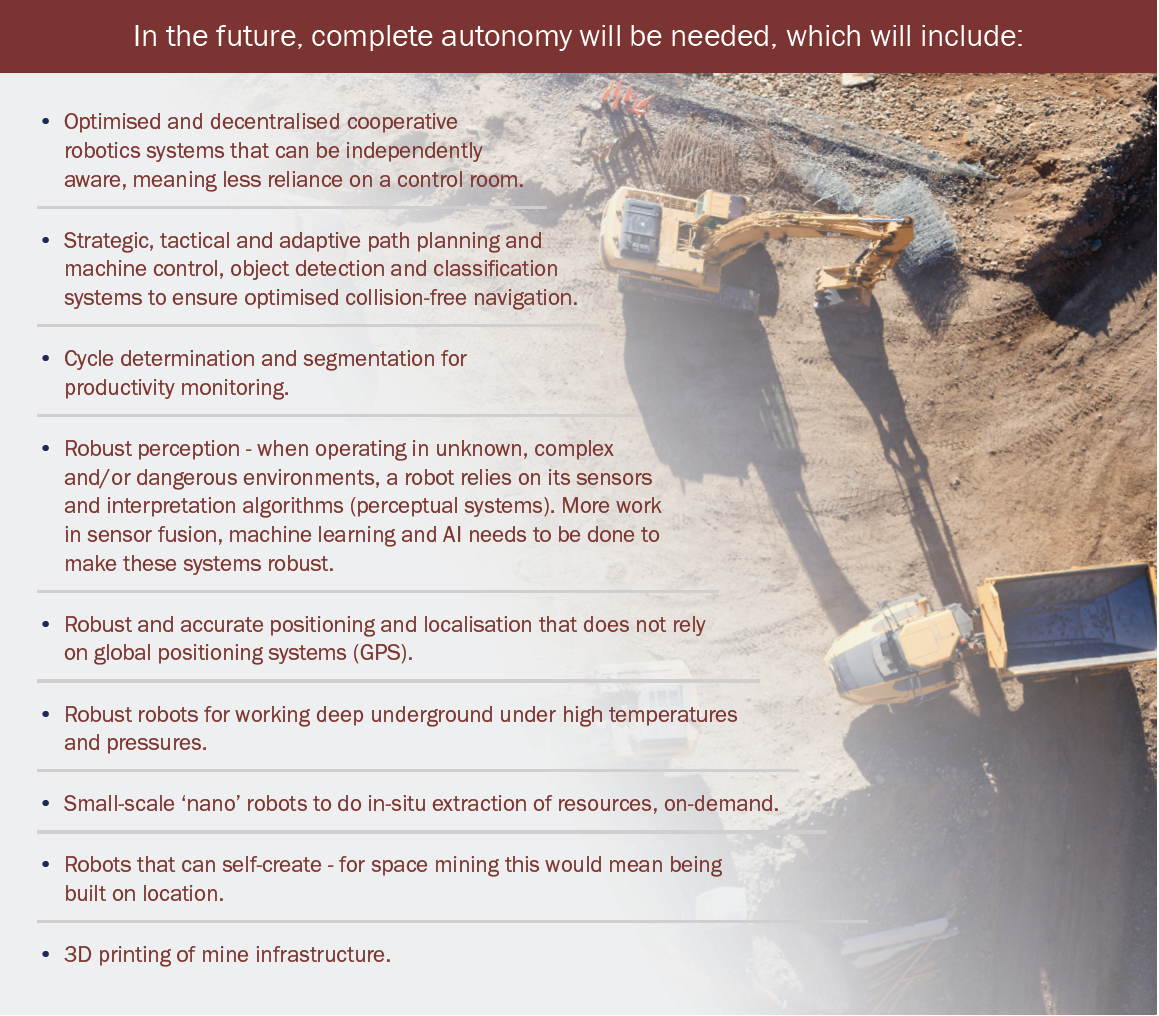
The future of robotics in the resources sector
The resources sector has a great opportunity to lead other sectors of the Australian economy and improve the overall low rates of automation and adoption in Australia. While the resources sector is by far the most advanced sector in terms of adopting automation, there are still areas where robotics can lead to further advances. The greatest ongoing impact for robotics in mining is between exploration and the mineral processing function. This phase encompasses mine planning, the actual mining process (drill / blast / load / haul) and comminution (breaking of rocks). Benefits of future application of robotics to mining [MZ15] include:
Changing the mining process into more precise and predictable operations as evident in manufacturing – for example, creating ‘a rock factory’,
The possibility of undertaking mining in geographic areas that would otherwise be unviable due to hazards and/or remoteness,
Miner safety and improvements to mining logistics and planning.
The mining industry is starting to embrace mobile automation in the form of haulage in open pits and loading in underground operations. This is already having a positive impact on production and safety for long-life bulk commodity mines. In the future, these benefits may be seen in shorter term specialist mining operations once autonomous equipment becomes cheaper, increases in functionality and flexibility, and encompasses greater interoperability.
The goal for resource companies is true automation whereby mining or resource extraction becomes non-entry, that is, human-less. Non-entry mining allows different (and sometimes more economical) geotechnical approaches to ground support and slope angles, increasing productivity and allowing access to previously sub-economic ore bodies. True automation of the mining process would also require the automation of the ancillary tasks, including geology, geotechnical, surveying and sampling. Non-entry resource extraction also allows mines to act more as warehouses, with the possibility of mining on-demand or just-in-time extraction of resources as they are required.
Second order value for mining companies is also bringing short interval control to the mining process. This is a well-established function in mineral processing and in oil and gas, but has remained elusive in the extraction sector due to its complexity and variability. This process requires the digital conversion and virtualisation of complex tasks, such as geology and geotechnical functions. This would require a significant effort in advanced computer vision, machine learning and AI capabilities. The Innovation and Science Australia 2030 plan [ISA17], suggests that the forthcoming Digital Economy Strategy should prioritise “the development of advanced capability in artificial intelligence and machine learning in the medium – to long-term to ensure growth of the cyber–physical economy.”
These changes require specific research and development in key areas that can play to Australia’s core strengths. Australia has the greatest latent domain knowledge in mining consulting services as well as being the leader in mining software. This reservoir of skills and knowledge in conjunction with our strength in computer vision provides Australia with a clear advantage in developing the complex blend of computer vision, machine learning and AI products.
New sensing and communication technologies will drive improved safety and productivity and enable greater automation and remote control. Australia is already a world leader in the development and export of integrated systems technology. Breakthroughs in automation, data analysis, modelling and resource processing have changed the nature of mining work. The rise in connectivity and remote sensing technologies is enabling the development of new remote monitoring and analytics solutions. This has allowed some METS companies to alter their business model from providing products, processes and services to working with producers to provide end-to-end services internationally, such as remotely monitoring mining operations.
Interoperability is one of the issues facing industries and companies seeking greater automation and application of robotics. Interoperability can pose a combination of technical, commercial and regulatory challenges. Most mine sites use a mix of equipment and fleet suppliers whose solutions do not communicate due to the sometimes significantly different network, safety, and control system related requirements of the robotic systems of each original equipment manufacturer (OEM). This challenge is being partially overcome. For example, OEMs like Caterpillar have recognised the need for interoperability and will, by 2019, have a substantial fleet (>20) of competitive trucks in blended autonomous operation.
Standards for interoperability for minerals and energy applications should be addressed. Who is accountable for safe operation of a blended/integrated system? Which element of the system will make decisions that will influence safe operation, e.g., speed limits? Who is responsible for validating new systems for safety and operational performance when new software releases impact across multiple providers? Many of these issues are currently being worked through for self-driving cars.

